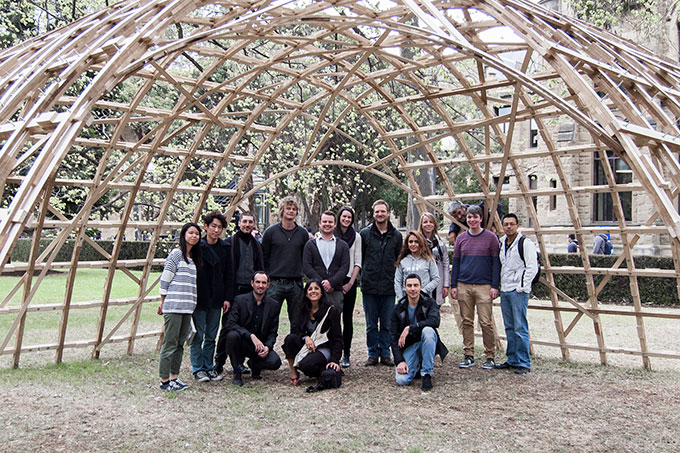Digital design and construction meets ancient technology
Graduate students from the Melbourne School of Design completed an intensive workshop that combined digital design and modern building materials with ancient construction techniques to assemble a timber gridshell with a footprint of 50m². The structure is now on exhibit on Union Lawn.

Constructed using a grid or lattice, a gridshell is a lightweight form-resistant structure that derives its strength from its double curvature and shape, which is called funicular, and is capable of covering large spans with minimal material use. Furthermore, the structure is the first post-formed gridshell constructed in Australia using a sustainable and highly durable treated wood product called Accoya.
The project formed the practical component of the Melbourne School of Design graduate level subject, Issues in Technology, which aims to improve students’ knowledge of low-tech building techniques and self-construction methods, in a strict relation with the use of advanced digital tools for the design and analysis of lightweight structures.
The sixteen strong student team completed the three stage construction process in less than five days. The initial stage of the project saw students assemble prefabricated timber laths into five foldable moduli first, and then as a flat grid on the ground. The structure was then bent and lifted to its final height of 3.5m using a construction tool developed by the ancient Greeks: the tackle. This technology enabled the flat grid to be moulded into the desired form using the strength of only four people. The final gridshell was then stabilised with diagonal bracing, which was optimised to reduce the amount of timber used and its maximum curvature, and a simple footing system. The structure spans 7.5m with an incredibly reduced thickness of 78mm.
Subject coordinator, Dr Alberto Pugnale, says the subject combines architecture, digital design and building technology to experiment and produce innovation in construction, “The value of our project is a strong connection between digital design and construction. The two aspects of the architectural project are merged together and inform each other.”
Dr Pugnale suggests this aspect is particularly relevant to shell and gridshell design, “The search for form is highly dependent on the materials and construction techniques used, but also on the final structural performance. Otherwise the structure won’t be lightweight.”
The subject also exposed students to innovative construction techniques according to Dr Pugnale, “Timber gridshells are based on the keywords of low-tech and self-construction. Therefore, we used very ancient systems of pulleys and tackles to lift the structure with no complex machineries, and everything was done using simple techniques,” he said.
Interaction between students and industry partners was another benefit of the MSD workshop. Professor Sergio Pone and Dr Sofia Colabella from Gridshell.it, an Italian company recognised worldwide and specialised in designing and constructing timber gridshells, provided design, structural and construction support to the project while Accsys Technology donated much of the building materials.
The MSD Gridshell is currently on display on Union Lawn, adjacenct to the Melbourne School of Design. Further information on the Issues in Technology subject and workshop is available online.